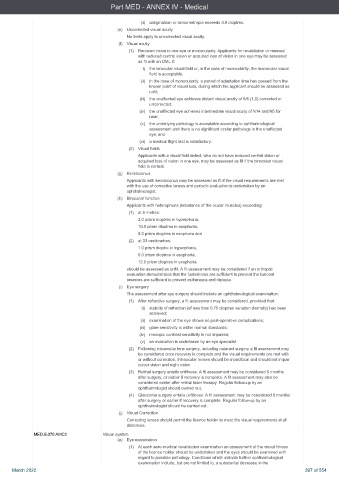Page 397 - UK AirCrew Regulations (Consolidated) March 2022
P. 397
Part MED - ANNEX IV - Medical
(ii) astigmatism or anisometropia exceeds 3.0 dioptres.
(e) Uncorrected visual acuity
No limits apply to uncorrected visual acuity.
(f) Visual acuity
(1) Reduced vision in one eye or monocularity: Applicants for revalidation or renewal
with reduced central vision or acquired loss of vision in one eye may be assessed
as fit with an OML if:
i) the binocular visual field or, in the case of monocularity, the monocular visual
field is acceptable;
(ii) in the case of monocularity, a period of adaptation time has passed from the
known point of visual loss, during which the applicant should be assessed as
unfit;
(iii) the unaffected eye achieves distant visual acuity of 6/6 (1,0) corrected or
uncorrected;
(iv) the unaffected eye achieves intermediate visual acuity of N14 and N5 for
near;
(v) the underlying pathology is acceptable according to ophthalmological
assessment and there is no significant ocular pathology in the unaffected
eye; and
(vi) a medical flight test is satisfactory.
(2) Visual fields
Applicants with a visual field defect, who do not have reduced central vision or
acquired loss of vision in one eye, may be assessed as fit if the binocular visual
field is normal.
(g) Keratoconus
Applicants with keratoconus may be assessed as fit if the visual requirements are met
with the use of corrective lenses and periodic evaluation is undertaken by an
ophthalmologist.
(h) Binocular function
Applicants with heterophoria (imbalance of the ocular muscles) exceeding:
(1) at 6 metres:
2.0 prism dioptres in hyperphoria,
10.0 prism dioptres in esophoria,
8.0 prism dioptres in exophoria and
(2) at 33 centimetres:
1.0 prism dioptre in hyperphoria,
8.0 prism dioptres in esophoria,
12.0 prism dioptres in exophoria
should be assessed as unfit. A fit assessment may be considered if an orthoptic
evaluation demonstrates that the fusinal rves are sufficient to prevent the fusional
reserves are sufficient to prevent asthenopia and diplopia
(i) Eye surgery
The assessment after eye surgery should include an ophthalmological examination.
(1) After refractive surgery, a fit assessment may be considered, provided that:
(i) stability of refraction (of less than 0.75 dioptres variation diurnally) has been
achieved;
(ii) examination of the eye shows no post-operative complications;
(iii) glare sensitivity is within normal standards;
(iv) mesopic contrast sensitivity is not impaired;
(v) an evaluation is undertaken by an eye specialist.
(2) Following intraocular lens surgery, including cataract surgery a fit assessment may
be considered once recovery is complete and the visual requirements are met with
or without correction. Intraocular lenses should be monofocal and should not impair
colour vision and night vision.
(3) Retinal surgery entails unfitness. A fit assessment may be considered 6 months
after surgery, or earlier if recovery is complete. A fit assessment may also be
considered earlier after retinal laser therapy. Regular follow-up by an
ophthalmologist should carried out.
(4) Glaucoma surgery entails unfitness. A fit assessment may be considered 6 months
after surgery or earlier if recovery is complete. Regular follow-up by an
ophthalmologist should be carried out.
(j) Visual Correction
Correcting lenses should permit the licence holder to meet the visual requirements at all
distances.
MED.B.070 AMC2 Visual system
(a) Eye examination
(1) At each aero-medical revalidation examination an assessment of the visual fitness
of the licence holder should be undertaken and the eyes should be examined with
regard to possible pathology. Conditions which indicate further ophthalmological
examination include, but are not limited to, a substantial decrease in the
March 2022 397 of 554

